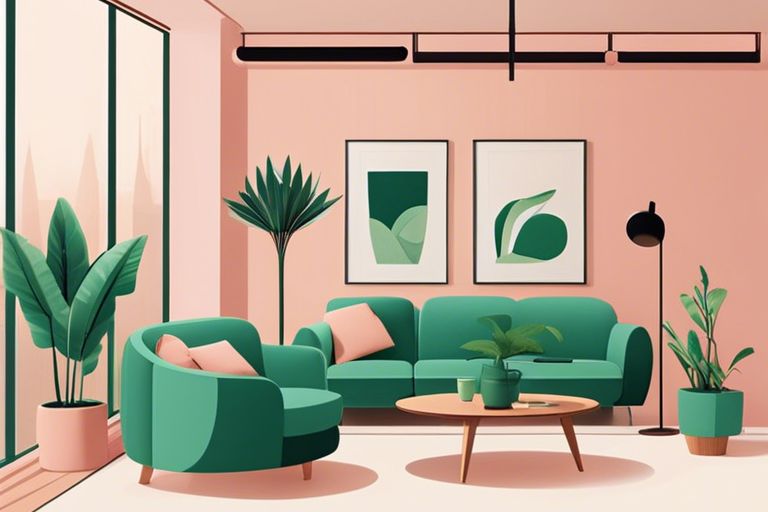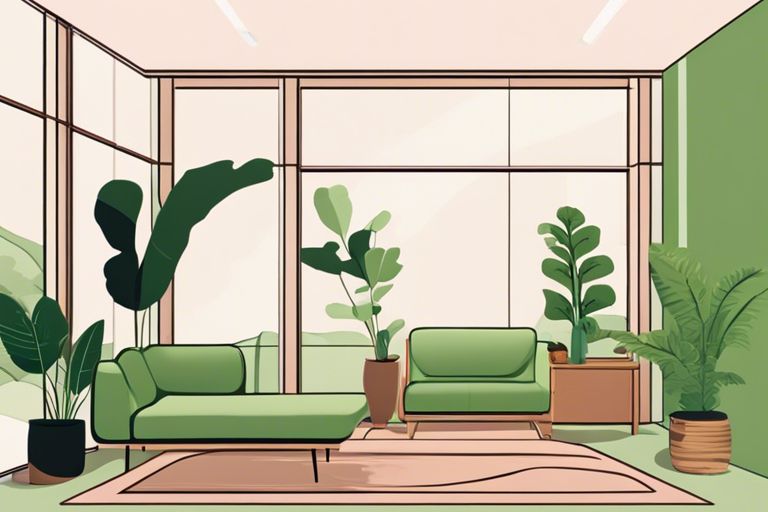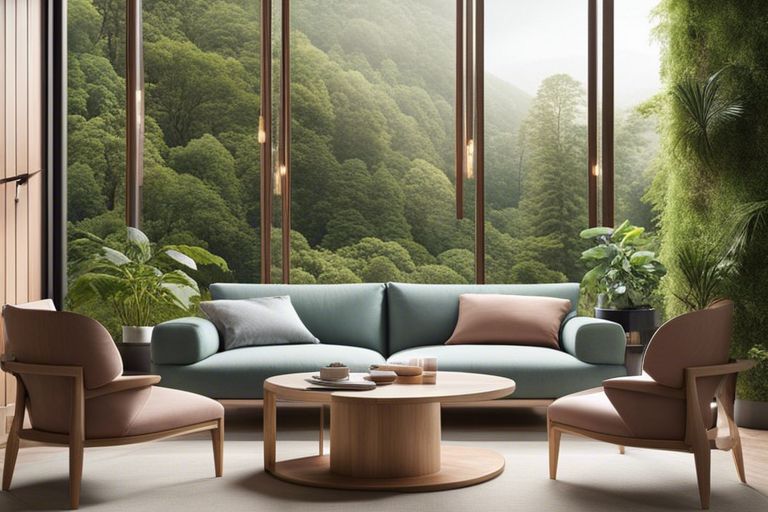Designing spaces that integrate nature into your surroundings can enhance your well-being in profound ways. In this guide to Biophilic Design, you will discover how connecting with nature within your living or working environment can improve your mental clarity, creativity, and overall happiness. Let’s probe into the fascinating world of Biophilic Design and learn how you can harmonize with nature for a more fulfilling life.
Key Takeaways:
- Biophilic design: Focuses on incorporating elements of nature into spaces to enhance human well-being and connection to the environment.
- Nature-inspired elements: Such as natural light, plants, water features, and views of nature, can help reduce stress, improve cognitive function, and boost creativity.
- Integration of nature: In interior and architectural design can lead to happier and healthier individuals, as well as more sustainable and aesthetically pleasing spaces.
Principles of Biophilic Design
Definition and History of Biophilic Design
The definition and history of Biophilic Design can be traced back to the concept of biophilia, which was first introduced by renowned biologist E.O. Wilson. Biophilia refers to the innate connection humans have with nature and other living organisms. Biophilic Design seeks to bring this connection into built environments, such as homes, offices, and public spaces, to enhance your health, well-being, and productivity.
The Science Behind Human-Nature Connections
The Science Behind Human-Nature Connections in Biophilic Design is grounded in research from various disciplines, including psychology, neuroscience, and environmental science. These studies have shown that exposure to nature, even in small doses, can have significant positive effects on your mental and physical well-being. By incorporating elements such as natural light, greenery, and natural materials into your surroundings, Biophilic Design aims to reduce stress, boost creativity, and improve cognitive function.
Benefits of Biophilic Design
Physical Health Benefits
Benefits: Now, let’s talk about the physical health benefits of biophilic design. Studies have shown that incorporating elements of nature into indoor spaces can lower blood pressure, reduce stress levels, and improve overall well-being. Exposure to natural light, vegetation, and natural materials has been linked to faster recovery times in healthcare facilities and increased physical activity in workplaces.
Mental Health Benefits
Health: Now, shifting our focus to mental health benefits, biophilic design has been shown to reduce anxiety, improve mood, and enhance cognitive function. Connecting with nature indoors can help you feel more relaxed, focused, and creative. By bringing the outdoors inside, you can create a calming environment that promotes mental clarity and emotional well-being.
Benefits: Additionally, biophilic design has been associated with increased attention spans, higher productivity levels, and better decision-making skills. By incorporating natural elements like water features, views of green spaces, and natural textures, you can create a more stimulating and engaging environment that supports cognitive function and enhances productivity.
Productivity and Cognitive Function
One: Research has found that exposure to nature within built environments can lead to improved concentration, faster recovery from mental fatigue, and enhanced problem-solving abilities. By incorporating biophilic elements into your workspace or home, you can create a more conducive environment for focus, creativity, and overall cognitive performance.
Mental: In today’s fast-paced and technology-driven world, it’s more important than ever to prioritize our mental well-being. By embracing biophilic design principles and incorporating elements of nature into our indoor spaces, we can create environments that support both our physical and mental health, ultimately leading to a more balanced and fulfilling lifestyle.
Design Elements for Biophilic Spaces
Natural Light and Ventilation
Keep in mind that natural light and ventilation are crucial elements of biophilic design. Elements such as large windows, skylights, and open floor plans can bring in ample natural light, while also allowing for better air circulation. This not only reduces the reliance on artificial lighting and air conditioning but also helps create a more inviting and comfortable environment.
Materials and Textures Inspired by Nature
Spaces inspired by nature incorporate materials and textures that mimic the natural world. Think of using wood, stone, bamboo, or cork in your design to bring elements of the outdoors inside. These Design choices not only add visual interest but also create a sense of warmth and connection to the environment.
Incorporating Plants and Greenery
Light is a key component of biophilic design, and incorporating plants and greenery into your space can greatly enhance the connection to nature. Whether it’s a small potted plant on your desk or a lush vertical garden in a common area, introducing living elements can improve air quality, reduce stress, and boost your overall well-being.
Inspired by the natural world, adding plants and greenery to your space can transform it into a verdant oasis. Consider creating designated plant areas or incorporating living walls to amplify the presence of nature indoors.
Applications of Biophilic Design
Many Biophilic Design Helps Homeowners Connect to Nature by bringing elements of nature into residential, commercial, and public spaces.
Residential Spaces
One way to incorporate biophilic design into your home is by adding natural elements such as indoor plants, water features, and natural light. These elements can help create a calming and peaceful environment, improving your overall well-being. Additionally, using natural materials like wood and stone in your home decor can further enhance the connection to nature.
Commercial and Office Spaces
Applications of biophilic design in commercial and office spaces can include green walls, biophilic furniture, and access to outdoor views. Implementing these elements can help reduce stress, increase productivity, and improve overall employee well-being. By creating spaces that mimic nature, you can create a more engaging and inspiring work environment.
Biophilic design in commercial and office spaces is not just a trend but a necessity in today’s fast-paced work culture. By incorporating nature-inspired elements, you can boost creativity, focus, and overall job satisfaction among employees.
Public and Community Spaces
Community parks, gardens, and urban green spaces are examples of how biophilic design can enhance public and community areas. These spaces provide opportunities for people to connect with nature, relax, and socialize. By integrating natural elements into urban landscapes, cities can promote environmental sustainability and improve the quality of life for residents.
To foster a sense of community and well-being, incorporating biophilic design principles in public spaces is imperative. These spaces serve as gathering points where people can interact with nature, fostering a deeper connection to the environment and promoting a healthier lifestyle.
Challenges and Limitations of Biophilic Design
Budget Constraints
Challenges – One of the primary obstacles you may encounter in implementing biophilic design is budget constraints. Incorporating elements such as natural light, greenery, and natural materials can be more expensive upfront compared to traditional design methods.
Climate and Environmental Factors
Challenges – When considering biophilic design, it’s imperative to take into account climate and environmental factors. The availability of natural light, access to outdoor views, and the presence of green spaces can vary depending on the location of your building. Perceiving the local climate and environment is crucial in designing a space that truly connects with nature.
Environmental Impact
Balancing Aesthetics and Functionality – Achieving a harmonious balance between aesthetics and functionality is key in biophilic design. While you want your space to look visually appealing with natural elements, it should also serve its purpose effectively. Limitations may arise when trying to strike this delicate equilibrium, requiring careful planning and consideration.
When incorporating biophilic design principles, it’s important to remember that while there are challenges and limitations, the ultimate goal is to create spaces that enhance your connection to nature and promote well-being. By being mindful of these factors and finding creative solutions, you can overcome obstacles and reap the numerous benefits that biophilic design has to offer.

Best Practices for Implementing Biophilic Design
Unlike traditional design approaches, biophilic design requires a collaborative effort between architects, designers, and other stakeholders to successfully integrate nature into built environments.
Collaboration with Architects and Designers
For a seamless integration of biophilic design elements, it is important to involve architects and designers from the early stages of the project. By working together, you can ensure that biophilic principles are incorporated into the overall design concept, selecting appropriate materials, lighting, and spatial arrangements that enhance the human-nature connection.
Involving Stakeholders and End-Users
The success of biophilic design depends greatly on the involvement of stakeholders and end-users throughout the design process. The preferences and needs of the people who will inhabit the space are crucial in creating environments that promote well-being and productivity.
Designers should engage with end-users through surveys, workshops, and feedback sessions to understand how they interact with natural elements and what features would most benefit them in the built environment.
Monitoring and Evaluating Biophilic Design Effectiveness
An effective way to ensure the success of biophilic design is to monitor and evaluate its impact on the users and the space itself. By collecting data on factors such as air quality, natural light exposure, and occupant well-being, you can assess the effectiveness of biophilic interventions and make adjustments as needed.
Understanding Monitoring and Evaluating Biophilic Design Effectiveness
Understanding the importance of monitoring and evaluating biophilic design effectiveness is crucial in creating spaces that truly enhance human well-being and connection to nature. By tracking key metrics and gathering feedback from users, you can continuously improve and refine biophilic design strategies for maximum impact.
Summing up
Following this insightful overview on Biophilic Design, you now have a deeper understanding of the importance of connecting with nature in our built environments. By incorporating elements such as natural light, greenery, and natural materials into your surroundings, you can enhance your well-being and productivity.
Recall, biophilia is ingrained in us as humans, and it is crucial to nurture this connection with nature for our overall health and happiness. So, whether you’re updating your workspace or designing your home, consider the principles of biophilic design to create spaces that truly amplify your connection to the natural world.
FAQ
Q: What is biophilic design?
A: Biophilic design is an innovative approach that incorporates elements of nature into the built environment to create spaces that enhance human health and well-being.
Q: How does biophilic design benefit people?
A: Biophilic design has been shown to reduce stress, improve cognitive function, boost mood, and increase productivity by fostering a deeper connection with nature.
Q: What are some examples of biophilic design elements?
A: Examples of biophilic design elements include natural light, indoor plants, water features, natural materials like wood and stone, views of nature, and outdoor spaces like gardens or rooftop terraces.


